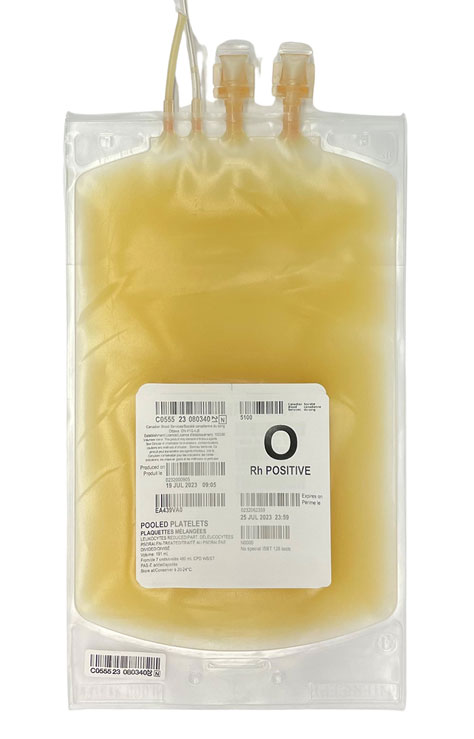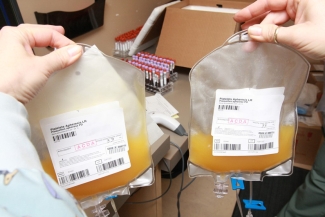ICTMG partners with AABB to advance platelet transfusion practice with publication of new international guidelines
Monday, June 23, 2025 Abby Wolfe
Platelets are the cells in blood that help stop bleeding by forming clots when an injury occurs. Platelets are given to patients who might develop bleeding, who are living with conditions that cause platelet dysfunction, or who have decreased platelet counts due to chemotherapy and other medical treatments.
While transfusions can be a life-saving medical intervention, any transfusion is not without risks. As demand increases, there is also a need to ensure that blood components like platelets are used in the most appropriate and beneficial ways to reduce shortages.
Clinical guidelines are a crucial resource, supporting decision-making around who should receive platelets to target the best outcomes while minimizing risks and balancing limited platelet supply.

What evidence about platelet transfusion is available for healthcare professionals around the world?
A 2021 review conducted by the International Collaboration for Transfusion Medicine Guidelines (ICTMG) revealed inconsistencies in the available platelet transfusion guidelines. Concerns included differences in transfusion thresholds – essentially, the point at which the number of platelets a patient has dips low enough that a transfusion would be considered – and dosing recommendations.
To address these gaps, the ICTMG conducted an additional systematic review of published evidence and then teamed up with AABB (the Association for the Advancement of Blood & Biotherapies) to create a new international guideline.
This new guideline was published in the high-impact medical journal, JAMA, in May 2025.
This guideline examines whether it is better to use liberal transfusion strategies (giving more platelets) or restrictive strategies (giving less) to transfuse platelets and makes recommendations for practice. Patient partners were involved in the development process to include the perspective of platelet recipients in identifying patient-important outcomes.
-
Access the full guideline and additional resources here: Platelets 2025 | ICTMG
Why are platelet guidelines needed?
Aarti Bathla is a clinical guideline program manager at Canadian Blood Services and supported the team that authored this new guideline. Says Aarti:
“When we think about platelets in general, they are a frequently used transfusion component but have both benefits and risks. Any time there is a controversial balance of benefits and risks, you want to address that by publishing the right guidance.”
Dr. Simon Stanworth, the Executive Chair of the ICTMG and a U.K.-based haematology expert who has published extensively in the transfusion medicine realm, including as a corresponding author on this latest guideline, explains:
“We hope our guideline provides the evidence that healthcare professionals need to transfuse platelets appropriately, including the threshold for when to consider starting a transfusion. Platelet transfusions are used in a variety of clinical settings in hospitals. A strength of this guideline was to provide guidance on the most effective way to use platelets in these different patient populations. This guideline also considers both pediatric and adult settings. It provides practical recommendations for the clinical use of platelets in patients with blood cancer, critical illness, intracranial hemorrhage, and for surgical procedures like lumbar punctures in patients with low platelet counts.”

If platelets help stop bleeding, why isn't it always ‘the more platelets the better’ for patients?
Acute transfusion reactions, transfusion-related acute lung injury (TRALI), and the increased risks of repeated exposure for patients who are frequently transfused are examples of serious considerations when determining whether a platelet transfusion is safe and appropriate.
For platelets in particular, different thresholds are used by healthcare professionals to determine when a patient might need a transfusion to ‘boost’ their platelet counts. These thresholds may differ across patient populations and indications, meaning a ‘one-size-fits-all' approach is not suitable to guide their use.
After rigorously reviewing the evidence from more than 34 clinical trials and studies, this guideline found little evidence to definitively state that giving more platelets resulted in better outcomes for patients. In fact, for some patient populations, recommendations indicate that platelet transfusions are either not recommended or that clinicians should adopt a more restrictive approach.
Dr. Susan Nahirniak, an Alberta-based transfusion medicine physician and medical director for Transfusion & Transplantation Medicine at Alberta Precision Laboratories, is a member of the ICTMG team that undertook the systematic review and guideline development. As she describes,
"These guidelines provide a framework for safer, more sustainable transfusion practice by promoting a shift toward restrictive platelet transfusion strategies. As a transfusion medicine specialist, I am excited about the prospect of those guidelines supporting a practice change amongst various specialties who currently may order platelet transfusions inappropriately. "

What is the ICTMG and what other transfusion guidelines has ICTMG published?
With a mission to inform the right transfusion, always, everywhere, the International Collaboration for Transfusion Medicine Guidelines is an independent collaborative of volunteers with expertise in transfusion medicine and related clinical disciplines, guideline development methodology and implementation research. The ICTMG Secretariat is hosted by Canadian Blood Services, which is the primary funder for ICTMG.
The ICTMG has completed publications and knowledge mobilization projects for many different transfusion medicine topics. In just the last five years, these have included guidelines on the use of intravenous albumin, red cells for patients with hemoglobinopathies like Sickle Cell Disease and Thalassemia, pre- & post-natal management of fetal and neonatal alloimmune thrombocytopenia (FNAIT), hemolytic disease of the newborn (HDN), and more.
Stay tuned for more blogs to follow in the coming weeks about ICTMG activities and related clinical guidelines.
Curious about the platelet donation process? Learn more about what happens when you donate platelets on blood.ca.
Canadian Blood Services – Driving world-class innovation
Through discovery, development and applied research, Canadian Blood Services drives world-class innovation in blood transfusion, cellular therapy and transplantation—bringing clarity and insight to an increasingly complex healthcare future. Our dedicated research team and extended network of partners engage in exploratory and applied research to create new knowledge, inform and enhance best practices, contribute to the development of new services and technologies, and build capacity through training and collaboration. Find out more about our research impact.
The opinions reflected in this post are those of the author and do not necessarily reflect the opinions of Canadian Blood Services nor do they reflect the views of Health Canada or any other funding agency.
Related blog posts
People with a low platelet blood count, such as cancer patients receiving chemotherapy, can receive a platelet transfusion to boost their platelet count. But what is the best approach to platelet transfusion? In its latest publication, the International Collaboration for Transfusion Medicine Guidelines examines the quality of seven platelet transfusion guidelines.
Since 2018, Canadian Blood Services has supported the development of evidence-based guidelines on red blood cell transfusion in patients with hemoglobinopathies through its work with the International Collaboration for Transfusion Medicine Guidelines (ICTMG). Hemoglobinopathies include sickle cell disease, thalassemia and other conditions that affect the structure, chemistry, or production of red blood cells. This blog describes recent efforts to update the ICTMG’s hemoglobinopathies guideline.
Blood is red. That’s because of the red blood cells or erythrocytes that whizz around your veins and arteries. The colour is a great visual marker, both clinically and emotionally, but sometimes its very redness hides the other important components that are in you to give. These include plasma, the...


